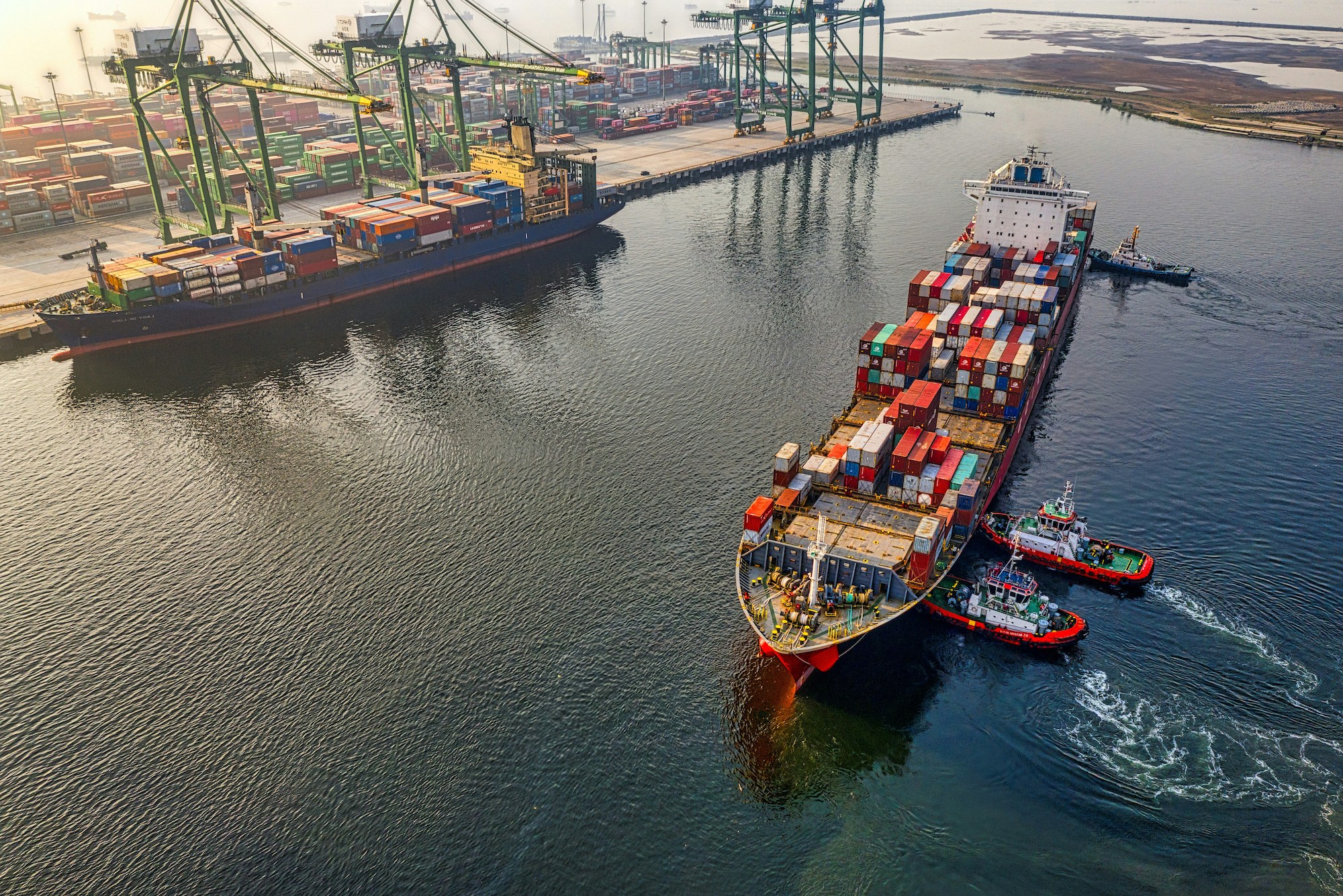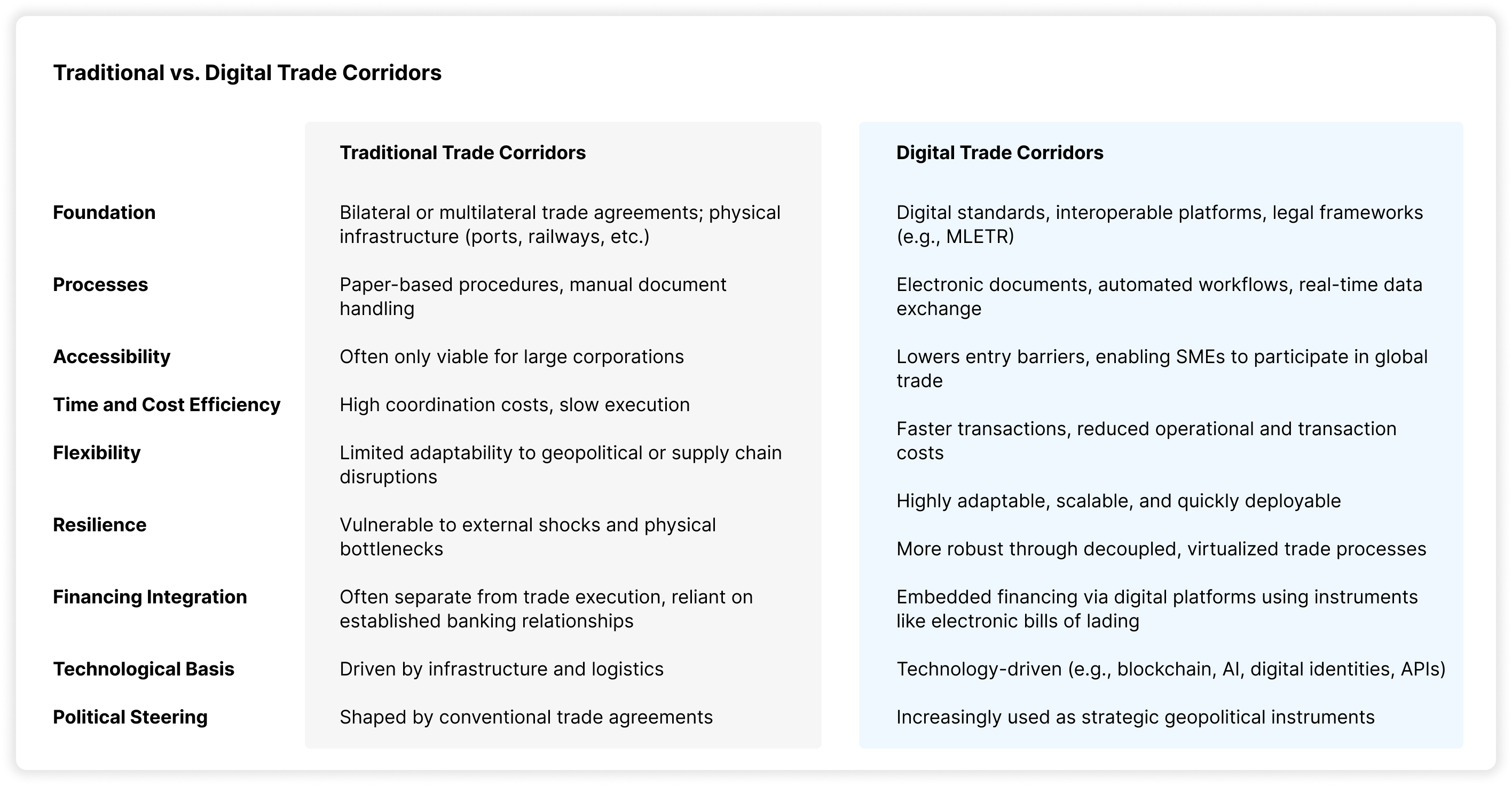Explore how digitalization is revolutionizing global trade by creating resilient and efficient digital trade corridors that overcome traditional constraints and open up new market opportunities.

Companies are increasingly exposed to external influences beyond their control. Political, macroeconomic, and environmental factors regularly lead to market disruptions. The global financial crisis, the COVID-19 pandemic, the war in Ukraine with its associated sanctions regimes, and the current protectionist trade policies of the United States are just a few examples of exogenous shocks over which companies have little influence.
This makes it all the more important to continuously optimize internal processes, safeguard existing trade relationships within geopolitical constraints, and proactively explore new markets and trade routes. The goal is to strengthen corporate resilience against future disruptions in a sustainable manner. One key enabler in this context is the ongoing digitalization of international trade, which not only enables more efficient processes but also facilitates the creation of new, digital trade corridors.
The Rise of Digital Trade Corridors
Digital trade corridors go beyond mere process automation. They create connected trade lanes based on standardized data formats, digital identities, electronic documents, and automated financing. Especially in geopolitically volatile regions, they offer a flexible and resilient alternative to traditional corridors.
Conventional trade corridors are built on bilateral agreements, physical transport routes, and mostly paper-based administrative processes. They are capital-intensive, slow to develop, and often difficult to access for small and medium-sized enterprises (SMEs). Digital corridors, by contrast, can be established more rapidly, are less dependent on geopolitical developments, and offer simplified market access, particularly for SMEs.
Legal and Technological Foundations
Alongside traditional free trade agreements, digital trade agreements are increasingly emerging. These agreements aim to facilitate the exchange of goods and services by establishing legal parity between electronic and paper documents, enabling cross-border data flows, and supporting digital contract execution. A recent example is the EU–South Korea Digital Trade Agreement, concluded in 2025, which sets binding standards for digital trade.
A legal foundation for these developments is the Model Law on Electronic Transferable Records (MLETR), developed by UNCITRAL. It provides the first internationally harmonized legal framework for transferable electronic documents such as bills of lading or guarantees—an essential building block for digitizing global supply chains. Countries such as Bahrain, Singapore, and the United Kingdom have already implemented MLETR, enabling fully digital documentation in cross-border trade.

Technology and Use Cases in Practice
A concrete example of how digital trade corridors can function in practice is a pilot project between Kazakhstan and China: In November 2024, a mid-sized Chinese company imported animal feed from Kazakhstan. The entire transaction was handled digitally:
Such a swift and seamless transaction would have been nearly impossible without digital infrastructure. For smaller businesses in particular, this greatly lowers the barriers to market entry.
Financing integration is another critical success factor. Platforms such as Komgo—FIATA’s official technology partner in developing the electronic Bill of Lading (eFBL)—enable the digital execution of financing instruments and provide digital proof of ownership. By connecting actors across the entire value chain, from commodity traders and banks to insurers, they create a secure, transparent, and automated digital ecosystem..
One politically significant example is the UK–UAE Trade Finance Corridor, launched in 2023. The initiative aims to establish a digital platform between the United Kingdom and the United Arab Emirates that offers harmonized verification mechanisms, risk assessments, and financing options for businesses. This corridor is not merely economic—it also serves a geopolitical purpose, positioning both countries as digital trade hubs bridging Europe, Asia, and Africa.
Similarly, the ASEAN region is advancing digital trade infrastructure through Digital Economy Agreements—such as those between Singapore, New Zealand, and Chile—which support the digitalization of cross-border commerce. These initiatives are also politically motivated, reflecting efforts to ensure technological sovereignty, reduce dependencies, and assert regional leadership in digital trade. The ASEAN case is just one of many active developments worldwide.
Technologically, digital trade corridors rely on interoperable platforms, APIs, blockchain technology, digital identities, artificial intelligence (AI), and standardized electronic documents. AI, in particular, plays a valuable role in risk analysis, fraud detection, and automated compliance checks. Nevertheless, the public debate need not focus on the technical underpinnings—what matters is that these technologies work seamlessly behind the scenes.
Effective digital corridors also require integration with existing systems. Only when customs authorities, banks, logistics providers, and businesses can exchange data securely, swiftly, and without media discontinuities can the full potential be realized.
Strategic Impact and Future Outlook
Despite all progress, one truth remains: Digital corridors do not replace physical trade infrastructure. Ports, railways, container terminals, and logistics hubs remain essential. Digital solutions virtualize processes, enhance transparency, and accelerate operations—but they do not substitute for physical transportation. It is the combination of physical infrastructure and digital processes that unlocks the full benefits.
Ultimately, digital trade corridors are more than just efficiency tools. They offer companies a strategic opportunity to hedge against geopolitical risk and tap into new growth markets. Those who invest today in digital standards, platform connectivity, and international interoperability will secure a stronger, more resilient position in tomorrow’s global trade landscape.
Watch this interview from Stéphane Graber, Director General at Fiata to learn more: